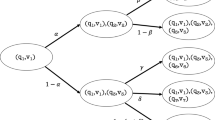Abstract
To analyze the individual and collective behavior of agents, a “state–probability of choice” model is proposed, based on considering the probabilities of choosing alternatives and using the Markov chain of changes in these probabilities. Further development of the direction associated with modeling the description of the decision-making situation is proposed. It explicitly sets the probabilities of decision-making based on the “state–probability of choice” model, provided that these probabilities can change over time. The proposed structuring of the model based on decomposition implies the formation of clusters of states, which can be provided with meaningful interpretation. The authors consider a two-level system of states, in which the base states correspond to specific probabilities of decision-making, and the states of the second level correspond to groups of states. It is shown that decomposition significantly weakens the factor related to the arbitrariness of the choice of base states. An example is given in which several groups of states are clearly distinguished, among which special attention is paid to the behavior of staunch supporters of certain alternatives, as well as to agents who hesitate.
Similar content being viewed by others
References
O. V. Oletsky, “On the approach to modeling the decision-making process in a multi-agent environment based on the Markov process of changing the probabilities of choice,” Nauk. Zap. NaUKMA, Komp. Nauky, Vol. 1, 40–43 (2018).
O. V. Oletsky, “On some necessary and sufficient conditions for equiprobable choice of alternatives within the Markov chain of the change of probabilities of choice,” Nauk. Zap. NaUKMA, Komp. Nauky, Vol. 2, 4–9 (2019).
O. V. Oletsky and E. V. Ivohin, “Formalizing the procedure for the formation of a dynamic equilibrium of alternatives in a multi-agent environment in decision-making by majority of votes,” Cybern. Syst. Analysis, Vol. 57, No. 1, 47–56 (2021). https://doi.org/10.1007/s10559-021-00328-y.
A. A. Letichevsky, “Algebraic interaction theory and cyber-physical systems,” J. Autom. Inform. Sci., Vol. 49, No. 5, 1–19 (2017).
S. Russell and P. Norvig, Artificial Intelligence: A Modern Approach, Prentice Hall (1995).
S. I. Nikolenko and A. L. Tulup’ev, Self-Learning Systems [in Russian], MTsNMO, Moscow (2009).
S. O. Mashchenko, “A mathematical programming problem with the fuzzy set of indices of constraints,” Cybern. Syst. Analysis, Vol. 49, No. 1, 62–68 (2013). https://doi.org/10.1007/s10559-013-9485-4.
T. Borgers, D. Krahmer, and R. Strausz, An Introduction to the Theory of Mechanism Design, Oxford Univ. Press, Oxford (2015).
T. Roughgarden, Twenty Lectures on Algorithmic Game Theory, Cambridge Univ. Press, Cambridge (2016).
R. A. Horn and C. R. Johnson, Matrix Analysis, Cambridge Univ. Press, Cambridge (1990).
O. Oletsky, “Exploring dynamic equilibrium of alternatives on the base of rectangular stochastic matrices,” in: CEUR Workshop Proc., Vol. 2917 (2021), pp. 151–160. URL: http://ceur-ws.org/Vol-2917/.
E. V. Ivokhin and D. V. Apanasenko, “Clustering of composite fuzzy numbers aggregate based on sets of scalar and vector levels,” J. Autom. Inform. Sci., Vol. 50, No. 10, 47–59 (2018). https://doi.org/10.1615/JAutomatInfScien.v50.i10.40.
O. I. Provotar and O. O. Provotar, “Fuzzy probabilities of fuzzy events,” Cybern. Syst. Analysis, Vol. 56, No. 2, 171–180 (2020). https://doi.org/10.1007/s10559-020-00232-x.
T. L. Saaty, The Analytic Hierarchy Process: Planning, Priority Setting, Resource Allocation, McGraw Hill (1980).
I. G. Chernorutskii, Methods of Decision Making [in Russian], BKhV-Peterburg, St. Petersburg (2005).
T. L. Saaty, Decision Making with Dependence and Feedback: The Analytic Network Process: The Organization and Prioritization of Complexity, RWS Publications (1996).
E. V. Ivokhin and Yu. A. Naumenko, “On formalization of information dissemination processes based on hybrid diffusion models,” J. Autom. Inform. Sci., Vol. 50, No. 7, 79–86 (2018).
O. S. Tryhub, R. O. Tryhub, and V. Gorborukov, “Researching semistructured problems of multicriteria optimization using the software system,” Nauk. Zap. NaUKMA, Komp. Nauky, Vol. 151, 79–88 (2013).
O. V. Oletsky and O. S. Trygub, “Applying the analytic hierarchy process for automated assessment of student works,” Nauk. Zap. NaUKMA, Komp. Nauky, Vol. 3, 127–131 (2020). https://doi.org/10.18523/2617-3808.2020.3.127-131.
Author information
Authors and Affiliations
Corresponding author
Additional information
Translated from Kibernetyka ta Systemnyi Analiz, No. 2, March–April, 2022, pp. 96–107.
Rights and permissions
About this article
Cite this article
Ivokhin, E.V., Oletsky, O.V. Restructuring of the Model “State–Probability of Choice” Based on Products of Stochastic Rectangular Matrices. Cybern Syst Anal 58, 242–250 (2022). https://doi.org/10.1007/s10559-022-00456-z
Received:
Published:
Issue Date:
DOI: https://doi.org/10.1007/s10559-022-00456-z




